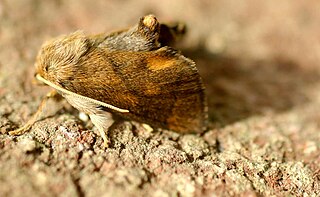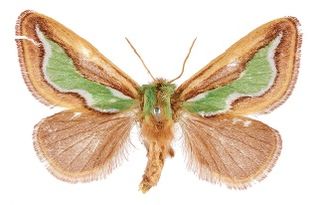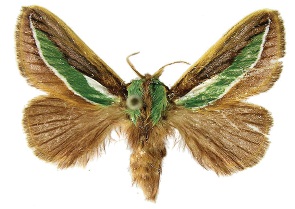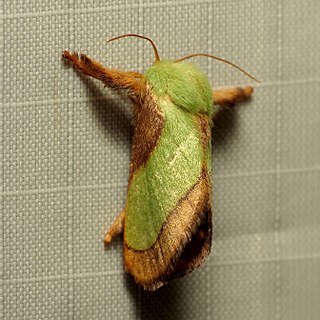
The Limacodidae or Eucleidae are a family of moths in the superfamily Zygaenoidea or the Cossoidea; the placement is in dispute. They are often called slug moths because their caterpillars bear a distinct resemblance to slugs. They are also called cup moths because of the shape of their cocoons.

Madina building is Waqf property and built in purpose of serve Hajj pilgrims built by the 7th Nizam of Hyderabad Deccan.

Parasa is a genus of moths of the family Limacodidae. It was described by Frederic Moore in 1860.

Parasa lepida, the nettle caterpillar or blue-striped nettle grub, is a moth of the family Limacodidae that was described by Pieter Cramer in 1799. It is a native minor pest found in the Indo-Malayan region, including India, Sri Lanka, Vietnam, Malaysia and Indonesia. It is an introduced pest to urban trees in western Japan.

Lithophane consocia, the scarce conformist or Softly's shoulder-knot, is a moth of the family Noctuidae. The species was first described by Moritz Balthasar Borkhausen in 1792. It is found throughout northern, central and eastern Europe, east to Siberia. There is a single record from Great Britain, where it was recorded in Hampstead, London, in September 2001.

Parasa indetermina, the stinging rose moth, is a moth of the family Limacodidae. It is found in the United States from New York to Florida, west to Missouri, Texas, and Oklahoma.
Melittia chlorophila is a moth of the family Sesiidae. It was described by Erich Martin Hering in 1935 and is known from Sierra Leone.
Eois consocia is a moth in the family Geometridae. It is found in Bolivia.

Parasa viridiflamma is a moth of the family Limacodidae. It is found in Taiwan. The habitat consists of mid-elevation mountain areas.

Parasa pygmy is a moth of the family Limacodidae. It is found in Taiwan, inhabiting mountains, at altitudes ranging from 2,000 to 3,000 meters.

Parasa undulata is a moth of the family Limacodidae. It is found in China.

Parasa minwangi is a moth of the family Limacodidae. It is found in the Nanling Mountains of southern China. The habitat consists of mid-elevation mountain areas.

Parasa martini is a moth of the family Limacodidae. It is found in Taiwan. The habitat consists of mid-elevation mountain areas with primary vegetation.

Parasa chloris, the smaller parasa, is a species of slug caterpillar moth in the family Limacodidae.
Anabolia consocia is a species of northern caddisfly in the family Limnephilidae. It is found in North America.

Parasa bicolor, the green rice moth, is a moth of the family Limacodidae. The species was first described by Francis Walker in 1855. It is found in Sri Lanka, India, Nepal, Pakistan, Myanmar, Laos, Taiwan, Vietnam, Malaysia, Java, China and Taiwan.
Parasa hampsoni is a moth of the family Limacodidae first described by Harrison Gray Dyar Jr. in 1894. It is found in Sri Lanka.
Stewart Moskowitz was an American artist, illustrator, and children's book author. His pop art style paintings gained popularity in the United States during the 1970s and early 1980s through the sale of posters and prints.
Parasa euchlora is a species of moth in the genus Parasa. It is in the family Limacodidae and the subfamily Limacodinae.













